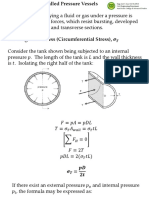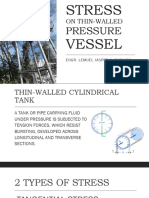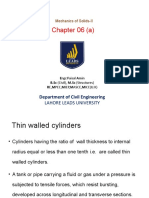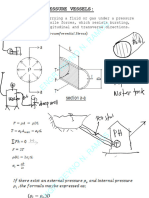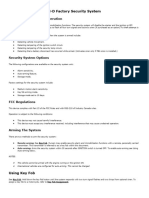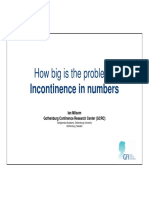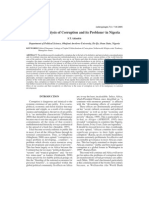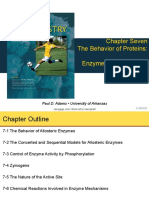THIN-WALLED PRESSURE VESSEL
A tank or pipe carrying a fluid or gas under a pressure is subjected to tensile forces, which resist bursting,
developed across longitudinal and transverse sections.
TANGENTIAL STRESS (Circumferential Stress)
Consider the tank shown being subjected to an internal pressure P. The length of the tank is L and the wall
thickness is t. Isolating the right half of the tank:
The forces acting are the total pressures caused by the internal pressure P and the total tension in the walls
T.
𝐹 = 𝑃𝐴 = 𝑃𝐷𝐿
𝑇 = 𝜎𝑡 𝐴𝑤𝑎𝑙𝑙 = 𝜎𝑡𝑡𝐿
∑𝐹H=0
𝐹 = 2𝑇
𝑃𝐷𝐿 = 2(𝜎𝑡𝑡𝐿)
If there exist an external pressure 𝑃o and an internal pressure 𝑃i, the formula may be expressed as:
LONGITUDINAL STRESS, 𝝈𝑳
Consider the free body diagram in the transverse section of the tank:
�The total force acting at the rear of the tank F must equal to the total longitudinal stress on the wall 𝑃𝑇 =
𝜎𝐿𝐴𝑤𝑎𝑙𝑙. Since t is so small compared to D, the area of the wall is close to 𝜋𝐷𝑡.
If there exist an external pressure 𝑃o and an internal pressure 𝑃i, the formula may be expressed as:
It can be observed that the tangential stress is twice that of the longitudinal stress.
SPHERICAL SHELL
If a spherical tank of diameter D and thickness t contains gas under a pressure of P, the stress at the wall
can be expressed as:
�SAMPLE PROBLEMS:
1. A cylindrical steel pressure vessel 400 mm in diameter with a wall thickness of 20 mm, is subjected to an
internal pressure of 4.5 MN/m2. (a) Calculate the tangential and longitudinal stresses in the steel. (b) To
what value may the internal pressure be increased if the stress in the steel is limited to 120 MN/m 2?
�2. The wall thickness of a 4-ft-diameter spherical tank is 5/16 inch. Calculate the allowable internal
pressure if the stress is limited to 8000 psi
�3. A water tank, 22 ft in diameter, is made from steel plates that are 1/2 in. thick. Find the maximum height
to which the tank may be filled if the circumferential stress is limited to 6000 psi. The specific weight of
water is 62.4 lb/ft3.
�4. The strength of longitudinal joint in the figure is 33 kips/ft, whereas for the girth is 16 kips/ft. Calculate
the maximum diameter of the cylinder tank if the internal pressure is 150 psi.
��5. A pipe carrying steam at 3.5 MPa has an outside diameter of 450 mm and a wall thickness of 10 mm. A
gasket is inserted between the flange at one end of the pipe and a flat plate used to cap the end. How many
40-mm-diameter bolts must be used to hold the cap on if the allowable stress in the bolts is 80 MPa, of
which 55 MPa is the initial stress? What circumferential stress is developed in the pipe? Why is it necessary
to tighten the bolt initially, and what will happen if the steam pressure should cause the stress in the bolts
to be twice the value of the initial stress?








